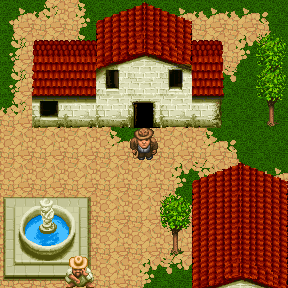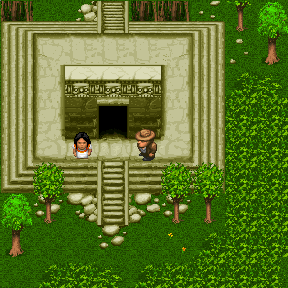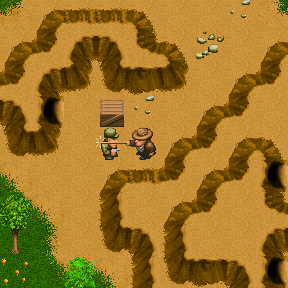Indiana Jones
and his Desktop Adventures
Info & History
HISTORY
"With games averaging under an hour, there's always a time for an Indy adventure break."
Indiana Jones and his Desktop Adventures was LucasArts' attempt at entering the "break game" market, dominated even to this day by classics like Minesweeper and Solitaire. Released on the 30th of April, 1996, the game was designed to be lightweight enough to run on any Windows 3.1 machine, and as easy to pick up and play as any of its competition. With game sessions taking between a few minutes to an hour (depending on the player's settings), the Desktop Adventures team had set their sights on the target audience of people on break at the office or dozing off during a lengthy business flight, and so on.

Hal Barwood, Desktop Adventure Project Leader
The game was initially conceived as an original project by Hal Barwood. Inspired by "classical, rhythmic, replayable games" like Stratego or Chess and exploring an interest in algorithmically combining small chunks of story and game elements into a replayable adventure, he set out to create a working prototype on a Mac in HyperCard, using the HyperTalk scripting language. The prototype had nothing to do with Indiana Jones, taking place instead in a post-apocalyptic future world where only an elite few know how to repair and maintain the few vital machines that preserve some semblance of human civilization. This prototype story was called Tools of the Tinker's Trade.
"The Jones game was a little bit experimental -- it was the first replayable story game ever, I think."
-Hal Barwood
-Hal Barwood
The LucasArts sales team didn't know how to sell the concept. Although the comparisons to pick-up-and-play games like Solitaire were already being made, selling people on the idea was another story. Barwood was eventually forced to drop the Tinker's Trade concept and reach for marketplace security in the form of Dr. Jones.
Sourced from an Indymag interview with Hal Barwood.
An advantage the game immediately had was that it was far more engaging than a simple card game - With a mix of gameplay reminiscent of early Zelda and the infinite possibilities of random generation, it provided an adventure rife with puzzles and danger to embark on. Though its gameplay was overly simplistic and repetitive, short bursts of playtime and nearly-infinite replay value meant that officegoers would get more than enough enjoyment out of the experience. Another advantage was that, for its low price of 12 to 20 Dollars at the time, it certainly lived up to its tagline: A whole lot of game for a low, low price.
On the other hand, the gaming public were used to a particular standard of quality from LucasArts, and the development team's focus on keeping the game lightweight meant that it paled in comparison to the audio-visual feasts that were LucasArts' other forays into the videogame scene - its small, simplistic graphics with minimal animation were often the first thing mocked in many a negative review written by the countless gamers who misguidedly compared this bite-size diversion to a feature-length adventure-gaming epic.
The very bullet points it was specifically designed for quickly became ammunition for the crowd that came in with the wrong expectations, with some like Charles Aradi of Computer Gaming World going as far as to compare the very inception of Desktop Adventures to that grand embarrassing LucasFilms flop, Howard the Duck.
Its target audience praised it for being a surprisingly fun diversion.
Computer Gaming World declared Indy's Desktop Adventures the 15th-worst computer game ever released.
"For a genius, George Lucas sure has a lot of bad ideas. [...] Some time ago, someone from his computer game division must have come to him and said, 'Hey, let's put out a really simple, randomly generated RPG-style adventure game, stick a whip in the hand of the main character, use the Indiana Jones name–and make it look really ugly.' And Lucas must have said, 'Sounds good to me.'"
-Charles Aradi, Computer Gaming World, Issue 145
-Charles Aradi, Computer Gaming World, Issue 145
Indiana Jones and his Desktop Adventures would go on to receive low-to-middling scores on review sites across the board. According to Barwood himself the game barely sold, but it clearly wound up selling well enough to encourage LucasArts to greenlight another installment in the Desktop Adventures series...
THE STORY
It's the mid-1930's, and Indiana Jones, Ph.D., excited by the fanastic finds emerging from the deserts and jungles of Middle America, travels south of the border to make his mark on archeology. The stated purpose of his expedition is to survey a temple complex known as Site R, but no sooner have Indy and his colleague, Marcus Brody, set up headquarters in the little town of Lucasio than they realize more important issues are at stake. Everywhere they turn, thieves and scavengers, many calling themselves scientists, are ransacking historical sites and selling off their priceless treasures to the highest bidder...
Soon Indy is embroiled in a dangerous contest, rushing to find a series of dazzling artifacts and get them into safe hands before his unscrupulous rivals, led by the shady collector Dr. Victor Van Loon and a crackpot Nazi general, Anton Schlossberg, can steal them.
As the player, you are Indiana Jones. At the start of each game, you should consult with Marcus on the latest emergency. He'll supply the first item you need to get going. From there it's up to you to explore, trade, and fight your way through dangerous terrain to resolve the crisis at hand.
CREDITS
The Desktop Adventures Team
Project Leader, Game Design & Story - Hal BarwoodLead Programmer & Game Design - Paul D. LeFevre
Lead Artist & Game Design - Tom Payne
Production Manager, Game Design & Story - Wayne Cline
Programmer - Mark Crowley
Lead Tester - Reed Derleth
Testers
Rachael BristolDarren Johnson
W. Ryan Kaufman
Theresa O'Connor
Dan Pettit
Josef A. Richardson
Jason Yunker
Sean "Alien Abductee" Matheis
John "Grandpa" Hannon
Scott Douglas
Matthew Azeveda
Jo "Captain Tripps" Ashburn
Sound
Music & Sound Effects Editing - Clint BajakianSound Effects Editing - Larry the O
Indiana Jones Theme Music - John Williams
Compatibility Testing
Lead Compatibility Tester - Doyle GilstrapJim Davison
Chip Hinnenberg
Creek Hart
Marketing
Product Marketing Manager - Tom ByronPackage Design - Soo Hoo Design
Public Relations Specialist - Tom Sarris
LucasArts Staff
President - Jack SorensenDirector of Sales and Marketing - Mary Bihr
Director of Production - Steve Dauterman
Director of Technology - Douglas Scott Kay
Director of Art - Collette Michaud
General Counsel - Bob Roden
Controller - Tom McCarthy
Manager of International Licensees - Lisa Star
International Production Manager - Cindy Leung
International Testing - Albert Chen
Public Relations Manager - Mark Cartwright
Quality ASsurance Supervisor - Dan Connors
Macintosh Conversion - Aaron Giles
Manager of Distribution and Manufacturing - Jason Horstman
National Sales Manager - Meredith Cahill
Non-Technical Support
Barbara BarwoodVenus LeFevre
Tara Reinertson
Anita Crowley
Matthew Russell
Bigrig Industries
Donizetti
Special Thanks to Steven Spielberg and George Lucas



